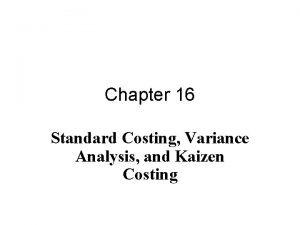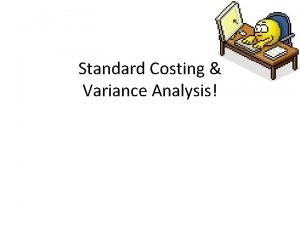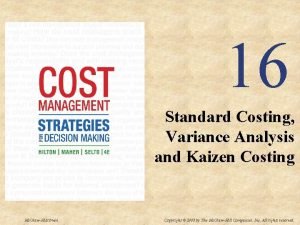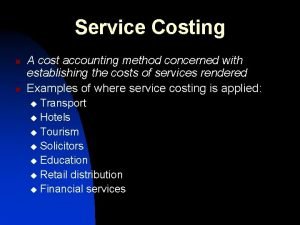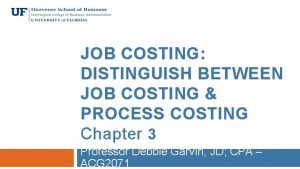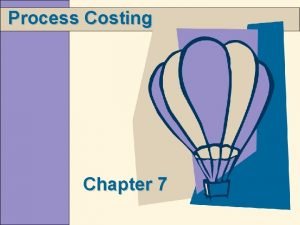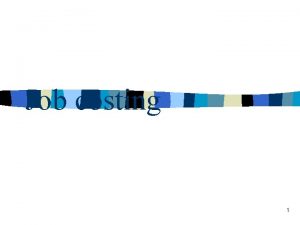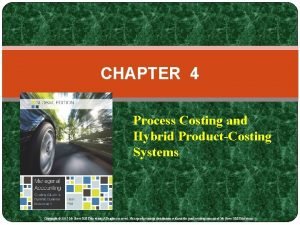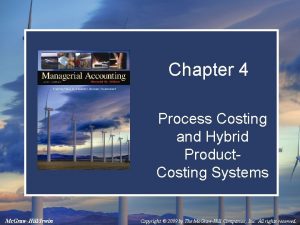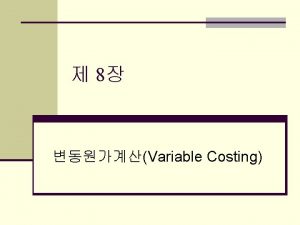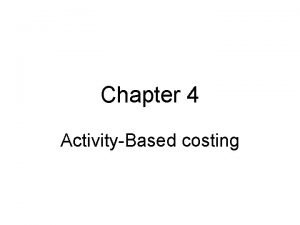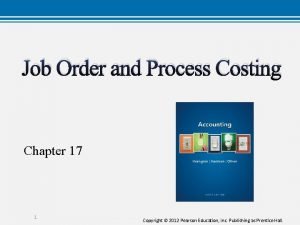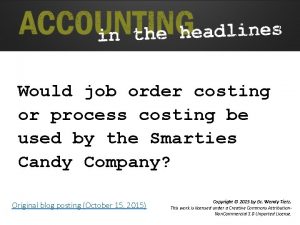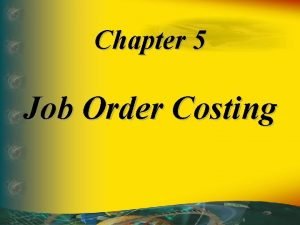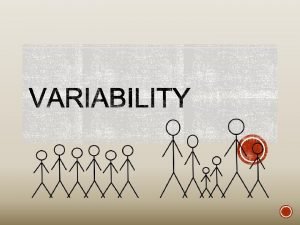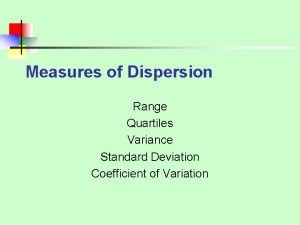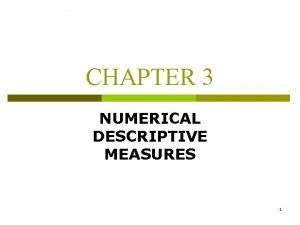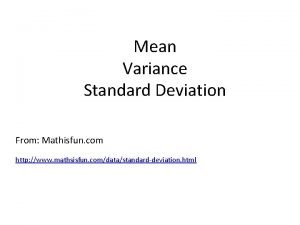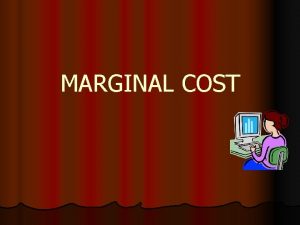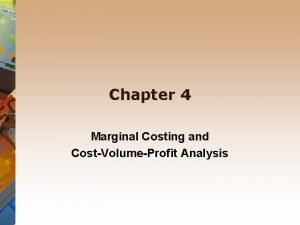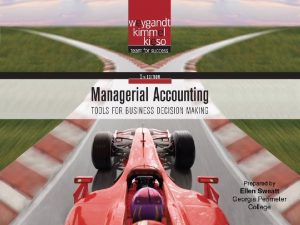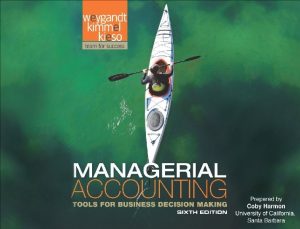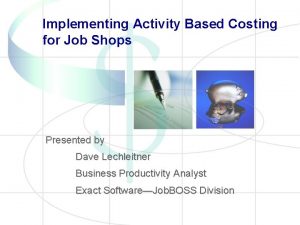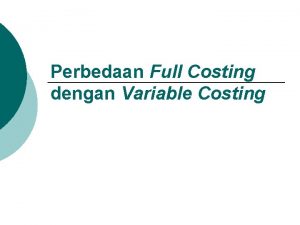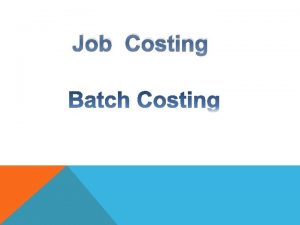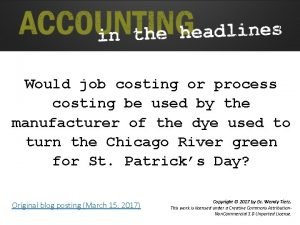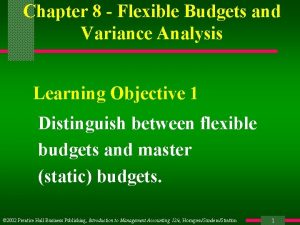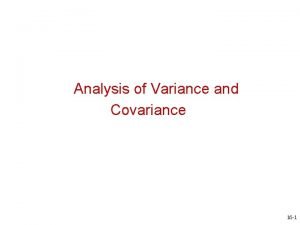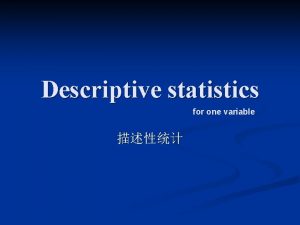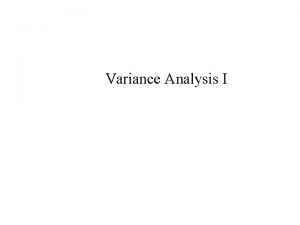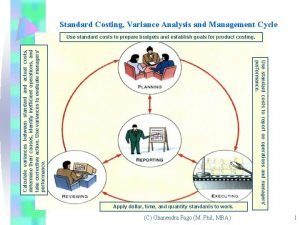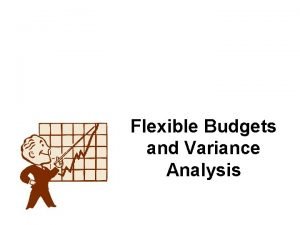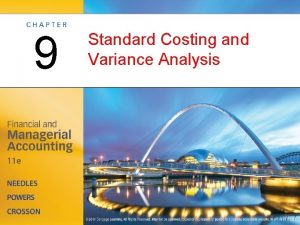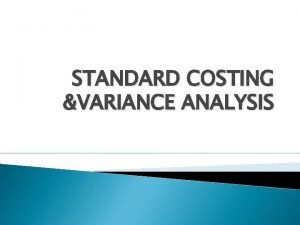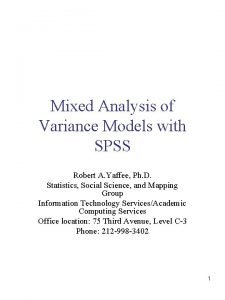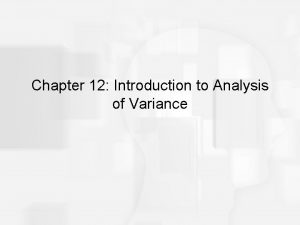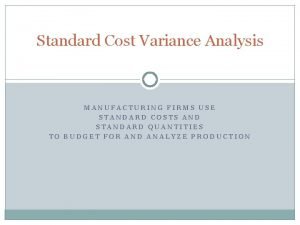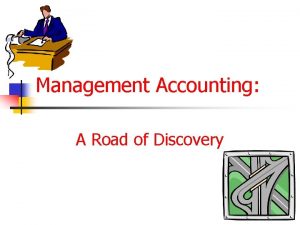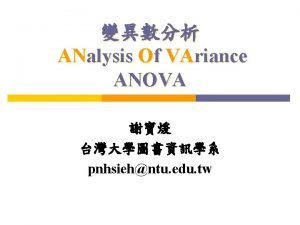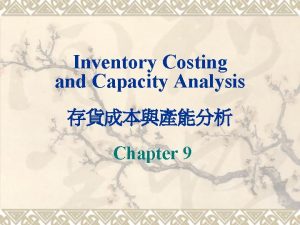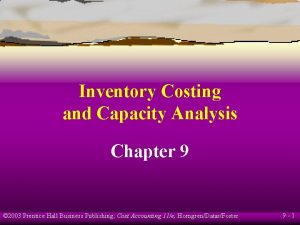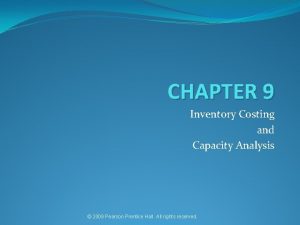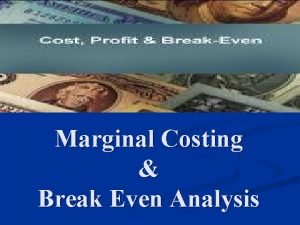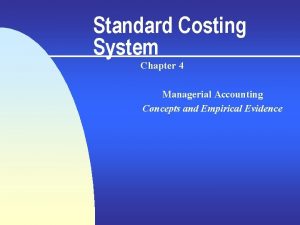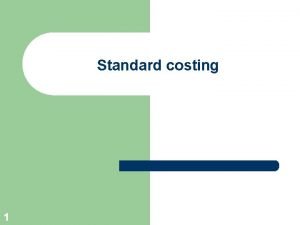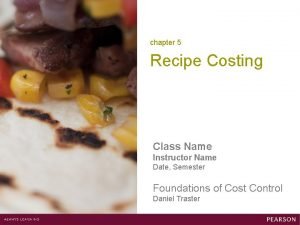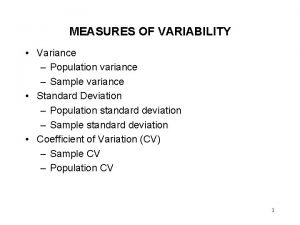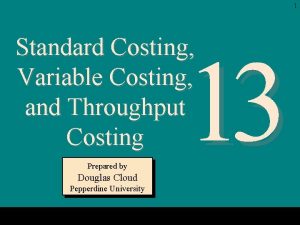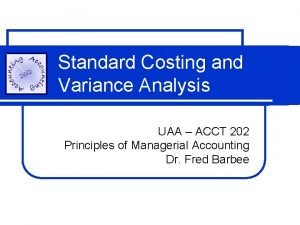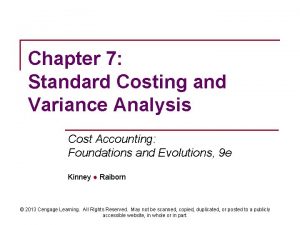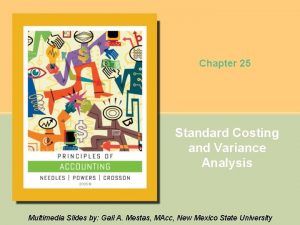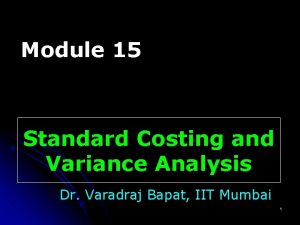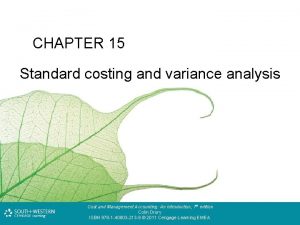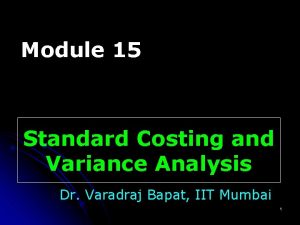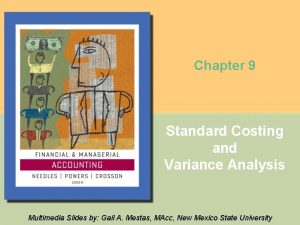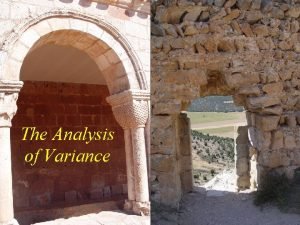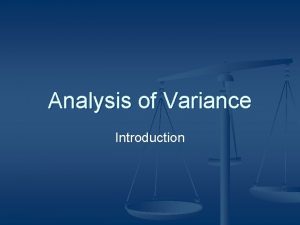9 Standard Costing and Variance Analysis Standard Costing



























































- Slides: 59

9 Standard Costing and Variance Analysis

Standard Costing OBJECTIVE 1: Define standard costs, and explain how standard costs are developed, and compute a standard unit cost.

Standard Costing • Standard costs: realistic estimates of cost based on analyses of both past and projected operating costs and conditions.

Standard Costing • The three components of standard costing: – Standard costs, which provide a standard, or predetermined, performance level – A measure of actual performance – A measure of the variance between standard and actual performance

Standard Costing • How standard costing differs from actual costing and normal costing. – Standard costing uses estimated costs exclusively to compute all three elements of product costs: direct materials, direct labor, and overhead.

Standard Costing • How managers use standard costs for planning and control in the management process: – Planning—For budget development; product costing, pricing, and distribution – Performing—For measurement of expenditures and control of costs as they occur

Standard Costing • How managers use standard costs for planning and control in the management process: (cont. ) – Evaluating—For variance analysis – Communicating—For variance reports

Standard Costing • The primary difference between standard costing in a service organization and standard costing in a manufacturing organization is that a service organization has no direct materials costs.

Standard Costing • In a standard costing system, costs are entered into the Materials, Work in Process, and Finished Goods Inventory accounts and the Cost of Goods Sold account at standard cost; actual costs are recorded separately.

Standard Costing • The following elements are used in determining a standard cost per unit: – Direct materials price standard – Direct materials quantity standard – Direct labor rate standard – Direct labor time standard – Standard variable overhead rate – Standard fixed overhead rate

Standard Costing • How standards are developed: – The direct materials price standard is based on a careful estimate of all possible price increases, changes in available quantities, and new sources of supply in the next accounting period.

Standard Costing • How standards are developed: (cont. ) – The direct materials quantity standard is based on product engineering specifications, the quality of direct materials, the age and productivity of machines, and the quality and experience of the work force. – The direct labor rate standard is defined by labor union contracts and company personnel policies.

Standard Costing • How standards are developed: (cont. ) – The direct labor time standard is based on current time and motion studies of workers and machines and records of their past performance. – The standard variable overhead rate and standard fixed overhead rate are found by dividing total budgeted variable and fixed overhead costs by an appropriate application base.

Standard Costing • Standard direct materials cost is the product of the direct materials price standard and the direct materials quantity standard.

Standard Costing • Standard direct labor cost is the product of the direct labor rate standard and the direct labor time standard.

Standard Costing • Standard overhead cost is the sum of the standard variable overhead rate and standard fixed overhead rate.

Standard Costing • A product’s standard unit cost is the sum of the following: – Standard direct materials cost – Standard direct labor cost – Standard overhead cost

© 2011 Cengage Learning All Rights Reserved. May not be scanned, copied or duplicated, or posted to a publicly accessible website, in whole or in part.

Variance Analysis OBJECTIVE 2: Prepare a flexible budget, and describe how managers use variance analysis to control costs.

Exhibit 1: Performance Report Using Data from a Static Budget

Exhibit 2: Flexible Budget for Evaluation of Overall Performance

Exhibit 3: Performance Report Using Data from a Flexible Budget

Figure 1: Variance Analysis: A Four-Step Approach to Controlling Costs

Variance Analysis • Variance analysis is the process of computing the differences between standard costs and actual costs and identifying the causes of those differences.

Variance Analysis • Role of flexible budgets – A flexible budget summarizes expected costs for a range of production levels: • Budgeted fixed and variable costs • Budgeted variable cost per unit

Variance Analysis • Role of flexible budgets (cont. ) – The flexible budget formula determines total budgeted costs for a range of levels of output.

Variance Analysis • Variance analysis has four steps: – Compute the amount of the variance. – Determine the cause of any significant variance.

Variance Analysis • Variance analysis has four steps: (cont. ) – Identify performance measures that will track those activities, analyze the results of the tracking, and determine what is needed to correct the problem. – Take corrective action.

© 2011 Cengage Learning All Rights Reserved. May not be scanned, copied or duplicated, or posted to a publicly accessible website, in whole or in part.

Computing and Analyzing Direct Materials Variances OBJECTIVE 3: Compute and analyze direct materials variances.

Figure 2: Diagram of Direct Materials Variance Analysis

Computing and Analyzing Direct Materials Variances • Total direct materials cost variance is the sum of the direct materials price variance and the direct materials quantity variance. – Direct Materials Price Variance = (Standard Price – Actual Price) × Actual Quantity – Direct Materials Quantity Variance = Standard Price × (Standard Quantity Allowed – Actual Quantity)

© 2011 Cengage Learning All Rights Reserved. May not be scanned, copied or duplicated, or posted to a publicly accessible website, in whole or in part.

Computing and Analyzing Direct Labor Variances OBJECTIVE 4: Compute and analyze direct labor variances.

Figure 3: Diagram of Direct Labor Variance Analysis

Computing and Analyzing Direct Labor Variances • Total direct labor cost variance is the sum of the direct labor rate variance and the direct labor efficiency variance. – Direct Labor Rate Variance = (Standard Rate – Actual Rate) × Actual Hours

Computing and Analyzing Direct Labor Variances • Total direct labor cost variance is the sum of the direct labor rate variance and the direct labor efficiency variance. (cont. ) – Direct Labor Efficiency Variance = Standard Rate × (Standard Hours Allowed – Actual Hours)

© 2011 Cengage Learning All Rights Reserved. May not be scanned, copied or duplicated, or posted to a publicly accessible website, in whole or in part.

Computing and Analyzing Overhead Variances OBJECTIVE 5: Compute and analyze overhead variances.

Exhibit 4: Flexible Budget for Evaluation of Overhead Costs

Figure 4: Diagram of Variable Overhead Variance Analysis

Figure 5: Diagram of Fixed Overhead Variance Analysis

Computing and Analyzing Overhead Variances • The total overhead variance is divided into two parts: – Variable overhead variances – Fixed overhead variances

Computing and Analyzing Overhead Variances • Using a flexible budget to analyze overhead variances – Total Budgeted Overhead Costs = (Variable Costs per Direct Labor Hour × Number of Direct Labor Hours) + Budgeted Fixed Overhead Costs

Computing and Analyzing Overhead Variances • Computing overhead variances – Computer total overhead cost variance – Total variable overhead cost variance is the difference between actual variable overhead costs and the standard variable overhead costs

Computing and Analyzing Overhead Variances • Computing overhead variances (cont. ) – The variable overhead spending variance (also called the variable overhead rate variance) is computed by multiplying the actual hours worked by the difference between actual variable overhead costs and the standard variable overhead rate.

Computing and Analyzing Overhead Variances • Computing overhead variances (cont. ) – The variable overhead efficiency variance is the difference between the standard direct labor hours allowed for good units produced and the actual hours worked multiplied by the standard variable overhead rate per hour.

Computing and Analyzing Overhead Variances • Computing overhead variances (cont. ) – The total fixed overhead cost variance is the difference between actual fixed overhead costs and the standard fixed overhead costs that are applied to good units produced using the standard fixed overhead rate.

Computing and Analyzing Overhead Variances • Computing overhead variances (cont. ) – The fixed overhead budget variance (also called the budgeted fixed overhead variance) is the difference between budgeted and actual fixed overhead costs. • Analyzing and correcting overhead variances

© 2011 Cengage Learning All Rights Reserved. May not be scanned, copied or duplicated, or posted to a publicly accessible website, in whole or in part.

Using Cost Variances to Evaluate Managers’ Performance OBJECTIVE 6: Explain how variances are used to evaluate managers’ performance.

Exhibit 5: Managerial Performance Report Using Variance Analysis

Exhibit 5: Managerial Performance Report Using Variance Analysis

Exhibit 5: Managerial Performance Report Using Variance Analysis

Using Cost Variances to Evaluate Managers’ Performance • To ensure that performance evaluation is effective and fair, a company’s evaluation policies should be based on input from managers and employees and should be specific about the procedures managers are to follow.

Using Cost Variances to Evaluate Managers’ Performance • Entering variances from standard costs into a performance report helps pinpoint areas of operating efficiency and inefficiency.

Using Cost Variances to Evaluate Managers’ Performance • A managerial performance report based on standard costs and related variances should – Identify the causes of each significant variance. – Identify the personnel involved.

Using Cost Variances to Evaluate Managers’ Performance • A managerial performance report based on standard costs and related variances should (cont. ) – Specify the corrective actions taken. – Be tailored to the manager’s specific areas of responsibility.

© 2011 Cengage Learning All Rights Reserved. May not be scanned, copied or duplicated, or posted to a publicly accessible website, in whole or in part.
 What is a static budget
What is a static budget Standard costing formula
Standard costing formula The formula for usage variance is (aq - sq) * sp.
The formula for usage variance is (aq - sq) * sp. Standard costing and variance analysis
Standard costing and variance analysis Standard costing vs kaizen costing
Standard costing vs kaizen costing Meaning of standard cost
Meaning of standard cost Difference between service costing and output costing
Difference between service costing and output costing Difference between job order costing and process costing
Difference between job order costing and process costing Contract costing definition
Contract costing definition Process and job order operations are similar in that both
Process and job order operations are similar in that both Process costing and hybrid product-costing systems
Process costing and hybrid product-costing systems Process costing and hybrid product-costing systems
Process costing and hybrid product-costing systems Hybrid costing example
Hybrid costing example Cost of production report example
Cost of production report example Job costing vs. process costing
Job costing vs. process costing Marginal costing and absorption costing
Marginal costing and absorption costing Target costing and activity based costing
Target costing and activity based costing Job cost record
Job cost record Job costing vs. process costing
Job costing vs. process costing Job order costing and process costing
Job order costing and process costing Job order costing process costing
Job order costing process costing Variance formula in standard deviation
Variance formula in standard deviation Range variance and standard deviation
Range variance and standard deviation Interquartile range formula excel
Interquartile range formula excel Interquartile range formula for ungrouped data
Interquartile range formula for ungrouped data Normal distribution calculator math is fun
Normal distribution calculator math is fun Absorption costing vs marginal costing
Absorption costing vs marginal costing Variable costing vs absorption costing
Variable costing vs absorption costing Marginal cost approach
Marginal cost approach Activity based costing formula
Activity based costing formula Advantages of activity based costing
Advantages of activity based costing Job shop pricing
Job shop pricing Perbedaan full costing dan variable costing
Perbedaan full costing dan variable costing Job costing vs batch costing
Job costing vs batch costing Metode full costing dan variable costing
Metode full costing dan variable costing Job costing with process costing
Job costing with process costing Multivariate analysis of variance and covariance
Multivariate analysis of variance and covariance Budget variance example
Budget variance example Analysis of variance and covariance
Analysis of variance and covariance Arithmetic mean merits and demerits
Arithmetic mean merits and demerits What is a static budget
What is a static budget Variance analysis cycle
Variance analysis cycle Variance analysis cycle
Variance analysis cycle Multiple analysis of variance
Multiple analysis of variance Direct materials variances
Direct materials variances Variance analysis definition
Variance analysis definition Mixed analysis of variance
Mixed analysis of variance Variance analysis in nursing
Variance analysis in nursing Introduction to analysis of variance
Introduction to analysis of variance When setting direct labor standards
When setting direct labor standards Variance analysis
Variance analysis Analysis of variance (anova)
Analysis of variance (anova) Chapter 9 inventory costing and capacity analysis
Chapter 9 inventory costing and capacity analysis Inventory costing and capacity analysis
Inventory costing and capacity analysis Inventory costing and capacity analysis
Inventory costing and capacity analysis Marginal costing and break even analysis
Marginal costing and break even analysis Standard costing system
Standard costing system Fixed overhead capacity variance formula
Fixed overhead capacity variance formula Standardized recipe cost sheet example
Standardized recipe cost sheet example Recipe development and standardization
Recipe development and standardization
